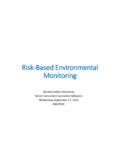Transcription of Particle Monitoring Requirements in Pharmaceutical …
1 Page 1 of 7 Particle Monitoring Requirements in Pharmaceutical Cleanrooms All drugs must be manufactured in accordance with the current Good Manufacturing Practice (cGMP) regulations. Pharmaceutical manufacturers must demonstrate compliance with the regulations at every stage before a drug can be released to market. This paper explains the various microcontamination Requirements of Pharmaceutical manufacturing, defines a clean manufacturing environment, and shows how to prove contamination control over an environment. Why do I need a Particle Counter? All drugs must be manufactured in accordance with the current Good Manufacturing Practice (cGMP) regulations which state that cleanroom validation must be performed and impose limitations for production environments.
2 In the United States these regulations are governed by the Food and Drug Administration (FDA) as the 21st Code of the Federal Regulations (CFR). In Europe, European Commission (EC) guidelines must be met. The Pharmaceutical company manufacturing the product must, therefore, prove that they have been in compliance with the regulations at every stage before a drug can be released to market and ultimately the end user. The US cGMP regulations govern various drugs manufacture activities including Organization and Personnel [21 CFR 211 Subpart B] Buildings and Facilities [21 CFR 211 Subpart C] Production and Process Controls [21 CFR 211 Subpart F] A Pharmaceutical company must have a quality control department that has the responsibility for drug approval independent of the production department.
3 This department is responsible for the routine quality assurances that: Establishes documented evidence which provides a high degree of assurance that a specific process will consistently produce a product meeting its predetermined specifications and quality attributes. FDA definition in General Principles of Validation, May 1987. To satisfy the Requirements , the products are manufactured in a controlled environment. Cleanrooms are employed to reduce the variability of potential production environments and as controlled environments can be regulated to meet specific standards.
4 GMP regulations require that these environments be rigorously monitored to ensure that there is full and constant awareness of current environmental conditions, both for viable and non-viable contamination. Cleanrooms A cleanroom is the fundamental starting point for contamination control. In the old Federal Standard 209E, a cleanroom is defined as a room in which air filtration, air distribution, utilities, materials of construction, and equipment are maintained in a controlled manner. Operational procedures are defined and regulated for airborne Particle concentrations to meet appropriate particulate cleanliness classifications.
5 ISO 14644-1 is the international standard of defining cleanroom contamination levels. Pharmaceutical cleanrooms are classified according to the Particle concentration of the air that is required to meet the cleanliness criteria for the manufacturing process being performed. Using the ISO standards, the higher the classification number, the lower the Particle concentration. Originally cleanrooms were classified according the number of particles per cubic foot at microns ( m). The determination of the cleanroom class is a process based on actual statistically valid measurements, as described in the following section.
6 Page 2 of 7 Particle Count Room Classification There are three measurement phases involving Particle counting in cleanrooms: As-Built: a completed room with all services connected and functional, but without production equipment or personnel within the facility. At Rest: all the services are connected, all the equipment is installed and operating to an agreed manner, but no personnel are present. Operational: all equipment is installed and is functioning to an agreed format, and a specified number of personnel are present, working to an agreed procedure.
7 The airborne Particle count test is performed by counting particles at defined grid locations within the as-built cleanroom . The test points should be equally spaced throughout the room and at work height to demonstrate the quality of the air cleanliness as it approaches the work area. Equipment location may result in modifications to the standard grid pattern. The number of measurements taken at each test point depends on the cleanroom class and the statistical Requirements specified in the standards. The standards also state that the data should permit defining the classification level with 95% confidence level.
8 It is recommended that a Particle counter capable of m sensitivity be used for the definition of classes ISO Class 5. To calculate the minimum number of samples required: Area (m2) Minimum sample volume is determined by 20 x 1000 Class limit Total required sample time (minutes): Minimum volume x minimum mumber samples Page 3 of 7 The following table shows the ISO14644- 1 cleanroom classifications. Pharmaceutical cleanrooms typically operate at Class 5 (most aseptic areas), Class 7 (surrounding areas), or Class 8 (support areas).
9 Pharmaceutical cleanroom Utilization We can prove that a cleanroom meets a standard using a Particle counter. The room classification achieved also dictates which production activities can be performed in the cleanroom . A document produced by the FDA and published in 2004 defines two areas. A critical area is where the sterilized drug product, containers, and closures are exposed to environmental conditions that must be designed to maintain product sterility, and a supporting clean area is where nonsterile components, formulated products, in-process materials, equipment, and container/closures are prepared.
10 The environmental Requirements for these two areas are given in the FDA Guide as follows: Critical area: This area is defined as critical because it contains sterilized products that, if exposed, are vulnerable to contamination. To maintain product sterility, it is essential that the environment in which aseptic operations are conducted be controlled and maintained at an appropriate quality. One aspect of environmental quality is the Particle content in the air. Particles are significant because they can enter a product as an extraneous contaminant and can also contaminate it biologically by acting as a vehicle for microorganisms.








